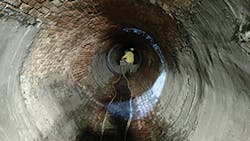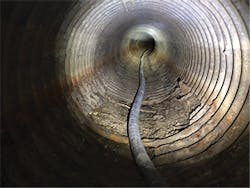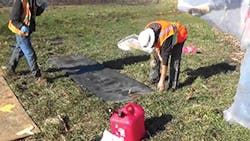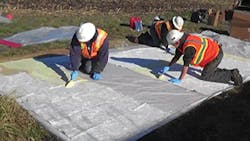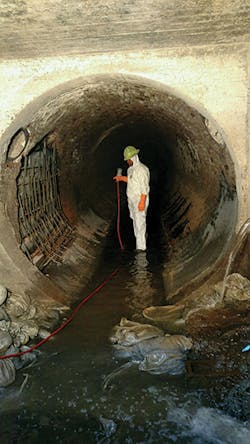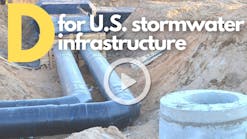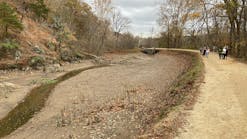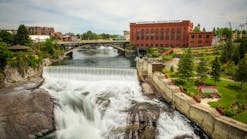The word infrastructure conjures images of solid and weighty materials and structures: concrete and steel, roads, rails, and bridges.
But ultimately, it’s about something much more fluid: movement—the movement of people, the movement of wildlife, and the movement of water. Functional infrastructure keeps things moving. Damaged infrastructure can bring that movement to a halt.
Those who manage the systems that keep stormwater moving face challenges that are universal (keeping tabs on miles of pipe that are out of view) and challenges that are regional (the effects of winter weather or the considerations of local wildlife).
In this article we examine four examples of stormwater pipe repair:
- a multiyear, citywide rehabilitation of aging corrugated metal in Kansas using spin-cast cement lining
- a series of point repairs to railroad culverts in rural Illinois
- a stream culvert rehabilitation using slip-lining not only to repair the culvert’s ability to move stormwater but also to enhance the culvert’s ability to provide safe passage for aquatic life
- a sinkhole at an intersection in downtown Omaha, which led to repairs to the brick storm pipe under the intersection, using spin-cast cement
All of the project managers and contractors used different processes and experienced different challenges along the way, but each shared the same goals: to keep everyone safe and to keep things moving.
24-inch CMP after cleaning, showing large hole in bottom of pipe
Cavity Prevention in Hays, KS
A cavity appeared in an old brick street in Hays, KS. Luckily, it was discovered before any cars broke through the pavement.
The cause? A 48-inch-diameter corrugated metal pipe that had deteriorated in the underground storm sewer system.
“That could have been catastrophic,” says John Braun, project manager for the City of Hays. “It brought to light the need to inspect the city’s storm sewer more frequently and more thoroughly.”
So Braun and his team in the city’s Office of Project Management set out to manually investigate the corrugated metal pipe (CMP) in the storm sewer system throughout the city. With flashlights in hand, they found that much of the CMP seemed to be approaching the end of its life. The pipe that had caused the cavity needed to be replaced, but that was the exception: most of the pipe could be repaired and rehabilitated without being removed. They considered various rehabilitation methods and found that spin-cast cement lining of pipes was the best option for them and the most cost-effective. They also felt concrete would hold up against the chemicals and salts from winter deicing operations.
The pipe rehabilitation undertaking was far-reaching for a city the size of Hays, which has a population of roughly 20,000. The work spanned several years and touched most of the system’s CMP that had reached the end stage of life.
The biggest part of the project took place over eight months in 2014 and 2015 and involved 9,766 linear feet of CMP at sites all over town. That represented about 6% of the city’s entire storm system. Pipe sizes ranged from 15 inches to 54 inches in diameter, and lengths ranged from 6 feet up to 400 feet.
The city contracted Mayer Specialty Services LLC based in Goddard, KS, to perform that part of the rehabilitation. Led by Todd Mayer, the company specializes in sanitary sewer, storm sewer, and water distribution services for municipal and industrial customers throughout the Midwest.
“The City of Hays had the project put together well,” says Mayer. “You need to have a good understanding of the condition of existing pipe, and they had good information.”
Mayer used the Strong-Seal system for stormwater infrastructure rehabilitation, which creates a concrete lining inside an existing pipe. The system, provided by The Strong Company Inc., includes Storm Seal, a fiber-reinforced cementitious mixture designed for rehabilitating corrugated metal pipes, culverts, concrete pipes, catch basins, and other stormwater structures. Storm Seal is centrifugally cast using the Strong-Seal Systems mixer, pump, and spinner. It can also be sprayed manually if the size of the pipe allows.
For each pipe, the first step for Mayer’s crew was to clean it. The amount of debris, gravel, rock, and silt they encountered along the way turned out to be one of the bigger hurdles to overcome, according to Mayer. “You have to have the pipe perfectly clean before you put the liner on. That was the most challenging, getting that debris cleaned out of those pipes.”
“[Our terrain is] pretty flat here, so our storm pipes have a low grade to them,” says Braun. “They tend to gather a lot of sediment, so there’s often more time spent prepping than actual lining.”
After diverting the water flow for the pipe being repaired, Mayer’s crew cleaned the pipe of all debris and water left behind. They power-washed the structure and then used a vacuum truck to remove everything so that the pipe was ready for the lining process. Typically they would spend a few days cleaning a particular run.
The bladder that will be coated in resin and inserted into the culvert
To apply the cement lining, they used an electronic winch control device to pull the spinner through at a consistent speed to make sure the coating was centrifugally cast at the specified thickness (1 inch) and was uniform throughout the length of the pipe. Including preparation, application, and cure time, the job was completed on schedule.
Braun and his team are pleased with the results. When asked what advice he would have for other cities thinking about the state of their own storm sewer systems, he notes it’s worth taking a close look at the system. “It’s one of those out-of-sight, out-of-mind issues that you just take for granted it’s working until something happens.”
He also emphasizes that it’s good to have an understanding of the infrastructure, but “also realize that it wasn’t all built in a day. And it doesn’t have to be repaired in a day. It’s not all bad at the same time. Be methodical, with a long-term maintenance and rehabilitation program.”
Railroad Culvert Point Repair in Rural Illinois
If any system needs a methodical approach to staying on top of any necessary culvert repairs, it’s the railroad system.
Culverts that run underneath railroad tracks bear some of the heaviest loads possible, and the ones in the northern part of the country also face punishing freeze-thaw cycles every year that can affect the pipes in the ground. And, because these culverts are not part of a road system, they are often not in an area where a problem would be noticed unless someone was actively looking.
That’s why with railroads, someone is indeed actively looking.
Doug Uitermarkt is one of the owners of Hurk Underground Technologies, a company that specializes in culvert cleaning, replacement, and repair. The company does a lot of work for railroads in particular, and Uitermarkt says he often gets called when a railroad inspector has proactively spotted a problem before it is big enough to have an impact on the track above.
Cavities in roads where people are driving their cars are understandably a high priority. Consider how much more critical it is when the weight that needs to be supported is a train. Culverts running underneath a single rail line range in length from 40 feet to 70 feet and are most often 36 inches in diameter. Concrete railroad culverts are usually assembled in sections of concrete measuring 8 or 10 feet each. Over time those sections start to separate, and those points of separation can lead to leaks.
Wetting the patch
Uitermarkt says that signs of a possible leak might include a sinkhole on the surface at ground level, between the tracks and the culvert. If the ground starts to give way, dirt will get sucked down during a storm—so the next step is to go down to the culvert to see if there is a pile of dirt at the bottom.
In November 2015, Uitermarkt and the Hurk Underground team were called on to rehabilitate 12 culverts 8 miles south of Rochelle, IL, that were starting to show signs of possible separations. The pipes did not need to be replaced, and though each pipe needed at least two repairs, those repairs could be safely performed using a method called point repair.
“You can fix a pipe for about a third of what it would cost to replace it,” says Uitermarkt.
In this case, according to Uitermarkt, railroad inspectors noticed the beginnings of a sinkhole during one of their proactive inspections. They created a temporary patch using rock and concrete, which keeps dirt out of the culvert and helps keep the cavity from growing until the permanent repair can be made.
Uitermarkt and his crew used the HammerHead Trenchless point repair system to patch the leaks. The process involves applying a silicate-based resin to the points of separation. The HammerHead epoxy resin is free of odor, styrene, and volatile organic compounds. In addition to repairing pipe separations, it can be used over offset joints and damaged siphons, to seal off interior drops and cap unwanted laterals, and to replace missing sections of pipe when needed.
The crew applies the resin to the points in need of repair by inserting into the culvert a bladder that has been coated in the resin. In each case they prep the bladder by first wrapping it with a plastic seal. Then they mix the resin with hardeners and apply the mixture with a spatula to a fiberglass mat. They have to work fast because as soon as the resin and hardeners are mixed together, the hardening starts to work.
Once the mat is covered in resin, they wrap the mat around the bladder, insert the bladder into the culvert, and then inflate the bladder so that it is tight enough up against the damaged area to allow the resin to form a bond with the existing pipe.
The bladder is allowed to sit long enough for the resin to harden, which usually takes anywhere from one to two and a half hours, depending on the air temperature. The crew then deflates the bladder and pulls it back out. It’s possible to remove it at that point because once the resin has dried, it lets go of the plastic that was wrapped around the bladder, allowing the bladder to be removed while the resin remains in place. According to Uitermarkt, crews can usually complete two to three patches in a day.
The finished patch is a load-bearing piece of pipe that restores structural integrity to the culvert and allows trains to run safely. The point repair process doesn’t interrupt train service. Crews can perform the work without disrupting the tracks.
Aside from the materials needed for the work itself, Uitermarkt says all that’s needed onsite is a small air compressor; the crew can transport everything they need on a truck. That’s a good thing, because one of the biggest challenges can be gaining access to the mouth of the culvert.
“It’s railroad track, not a highway, so the nearest crossing might be two miles away,” says Uitermarkt. “We may have to go through a field or cross a creek.”
Once again, movement is key.
Rehabilitating Culverts While Protecting Aquatic Life in New England
Although human life is obviously of paramount importance when assessing the status of stormwater systems that run under intersections, roads, and railroads, contractor Travis Stearns in Maine has another form of life to consider in his pipe rehabilitation projects: aquatic life.
The US Fish and Wildlife Service reports that each year millions of fish migrate to their native habitats, but when fish can’t complete their journey, they can’t reproduce and build sustainable populations. According to the North Atlantic Aquatic Connectivity Collaborative, road crossings and culverts can alter habitats and disrupt the continuity of river and stream ecosystems.
So, in addition to effectively moving stormwater and allowing streams to continue underneath roads, the culverts that Stearns is called upon to repair need a design that minimizes the impact on the ability of fish to get where they need to go.
Travis Stearns is the owner of C.L.H. & Son Inc., a Maine-based company that specializes in rehabilitation of aging culverts throughout New England. His company has done work that involves repairing damaged culverts while simultaneously creating fish passages, to ensure that a culvert doesn’t eliminate the spawning route of migratory fish.
Stearns says there are several things to consider and design for when repairing stream culverts that also handle storm runoff. For one thing, the flow of the water needs to be slowed to allow fish to migrate more easily.
“The fish don’t survive with too much velocity,” says Stearns.
They also need a design that allows for water to pool in areas to create a series of ponds, even in situations when the flow of the water is low. Maintaining a precise and consistent slope throughout the length of the pipe is also critical.
Stearns’ company was called upon to repair a culvert that runs under Route 66 in Marlborough, CT, where a stream that also handles storm runoff runs underneath the road. Like many of the existing stream culvert pipes that he repairs, this one was corrugated metal that had deteriorated. It needed repairs that would not obstruct and, even better, would actually enhance the ability of aquatic life to pass through.
His method of choice is slip-lining, using the Snap-Tite Culvert Lining System from ISCO Industries. Slip-lining eliminates the need to excavate the old pipe by allowing a new lining made of high-density polyethylene (HDPE) to be inserted into the failing pipe. Segments of Snap-Tite pipe can be snapped together forming strong, watertight seals.
Normally, Stearns would not be able to use a product made of HDPE in a culvert that accommodates aquatic life, because the smooth walls create a flow velocity that would be too high. But ISCO created a Snap-Tite product designed for this scenario. The ISCO Aquatic Life Passage includes HDPE pipe designed with what the company calls “roughness elements” to decrease flow velocity and allow for some silt and streambed material to collect inside.
“The Aquatic Life Passage is handy,” says Stearns. “HDPE is the best product you can get. Being able to get it with interior corrugation for these fish passages is unusual.”
For the project under Route 66 in Marlborough, there were twin pipes—two 54-inch pipes side by side, each 125 feet long. Both were slip-lined with the Aquatic Life Passage. One pipe was designed to maintain a normal flow, while the other was designed to be fish-friendly. To achieve that, the crew added weirs—barriers to alter the flow characteristics. The weirs help slow the flow of the water, create small pools of standing water, and also provide resting areas for fish to use during high-velocity events. The crew also created a series of pools that serve as a fish ladder the at end of the pipe, so fish could get back upstream.
Then they filled the voids around the culvert and also between the lining and the old pipe with lightweight cellular grout. That serves to reinforce the stability of the culvert overall and the ground around it, and it also helps keep the new HDPE pipe precisely in place—something that is even more critical when dealing with fish and the need to maintain the desired elevation and slope of the pipe to help with fish passage.
“The fact that Snap-Tite was able to provide this specialized solution—it’s a pretty big deal,” says Stearns. “It allows you to get the long-term benefits of HDPE and also provide aquatic life solutions.”
The Omaha pipes were part of the combined sewer system.
Fixing a Sinkhole in Downtown Omaha
When the street started settling at the intersection of 7th and Jones in downtown Omaha, NE, the city discovered structural issues that needed immediate repair.
Below ground, in the combination stormwater and sewer system, part of a 60-inch lateral line had failed at the point at which it connects to the 90-inch trunk line. That’s the failure that had caused the sinkhole, but it wasn’t the only failure. Fifty feet away there was also a missing wall—a brick wall separating two trunk lines had collapsed. The pipes (a 90 inch and a 102 inch) sit parallel to each other, side by side. The center brick wall separating them had collapsed, leaving a large open area where there should have been two separate pipes.
“You’re not supposed to be able to see from one pipe to the other,” says Bryan Dobson, operations manager for Kansas City-based Ace Pipe Cleaning Inc.
According to Dobson, there were four points of failure that needed repair within about 50 feet of each other under the intersection. All involved reconstructing or patching brick pipe wall, then recasting the interior with a cement lining.
Omaha-based Roloff Construction was contracted to manage the project and excavate the original pipe; Alfred Benesch and Company of Omaha was the consultant. They brought in Ace Pipe Cleaning, a Carylon Company, to perform the pipe rehabilitation using CentriPipe centrifugally cast concrete pipe from AP/M Permaform. CentriPipe creates a new cement pipe inside an existing pipe without the need for dig and replace, and the new lining can be engineered to meet the loading requirements for roads, bridges, trains, and airports.
After clearing the area of all debris and any standing water, Ace Pipe Cleaning constructed a base and new pipe wall for the interior wall to separate the 90-inch and 102-inch pipes. They used AP/M Permaform’s MS-10,000 high-strength, corrosion-resistant mortar, shaping it to match the arc of the existing pipe wall. They used the same mortar to patch and seal two other areas on the walls of the pipes in need of repair and also to repair the connection point where the 60-inch pipe meets the 90-inch line.
They successfully kept the street from collapsing or settling further by drilling a hole in the pavement and pumping a lightweight fill into the void.
Once all the repairs were made, they lined 55 linear feet each for both of the trunk lines, centrifugally casting a full-circumference cement lining inside each pipe. AP/M Permaform’s PL-8000 concrete adheres to any substrate—concrete, clay, metal, or brick—and cures in place within hours. The CentriPipe system provides waterproofing, sealing, structural reinforcement, and corrosion protection, extending the life of existing storm sewer pipe.
A pole camera lowered into a pipe
Dobson says the work took about a month to complete, during which time the intersection was barricaded and traffic had to be diverted.
As Dobson puts it, “It all began with a street settling.”
And now the storm system underneath 7th and Jones has gained a new lease on life.
Inspecting Those Hard-to-Reach Areas
How do you get a good look at your underground pipe network when you don’t have the option of walking through with a flashlight in hand?
Dan Cruickshank is asset management data specialist for Prein&Newhof, an engineering firm in Michigan that works with municipalities and local road agencies to manage their stormwater infrastructure. His company creates asset management programs for roads and utility systems.
He says the factors that usually have an impact when deciding how to inspect a network of underground stormwater pipes are budget, schedule, and level of detail necessary. Depending on these factors, he recommends using a combination of methods to make the most of the budget and to get the best views. That combination typically includes a closed-circuit television (CCTV) crawler camera and a pole camera like the Quickview from Envirosight. Prein&Newhof owns and operates multiple Quickview systems and subcontracts the CCTV work.
A pole camera like the Quickview uses a zoom camera on a pole, letting inspectors assess storm lines by lowering the camera down from an adjoining manhole or carrying it with them to look into other tight spaces. Crawlers are CCTV cameras on wheels, available in multiple sizes, to allow visibility in networks of pipes that would be too small to enter or otherwise inaccessible.
Prein&Newhof has conducted numerous system-wide condition assessment surveys for clients, using Quickview cameras to inspect hundreds of thousands of feet of storm sewer as part of these projects. The company also performs underground pipe inspections before the start of work on road projects to ensure a client will not have to dig up a brand new road to repair sewer defects.
Cruickshank says another important factor influencing inspection method is accessibility: “Some sewers located off-road or in difficult terrain cannot be easily accessed by a CCTV truck. In these areas, a pole camera is a good solution, because it can be carried wherever a crew can walk. Using the two methods in tandem often results in the best solution.”
According to Cruickshank, pole cameras offer a quick and inexpensive way to visually inspect underground pipe and obtain preliminary condition assessments. They are an ideal prescreening tool for CCTV since they can inspect large quantities of pipe, quickly identifying pipes that warrant a more thorough inspection with a crawler camera. This method saves significant cost compared to performing a CCTV inspection of the entire pipe system.
A CCTV crawler camera is a good method when greater detail is needed, or when inspectors need to see beyond the visual range of a Quickview camera—for example, where a section of pipe is laid with a slight curve or settling has led to excessive joint offset. A crawler camera also is necessary when crews need to know the exact location of a defect, such as when spot repairs are planned.
“We recommend the dual approach of using Quickview to get a preliminary system assessment and following up with CCTV in pipes that warrant additional detail,” says Cruickshank. “For half the cost of CCTV, we can prescreen three times as much pipe.”
